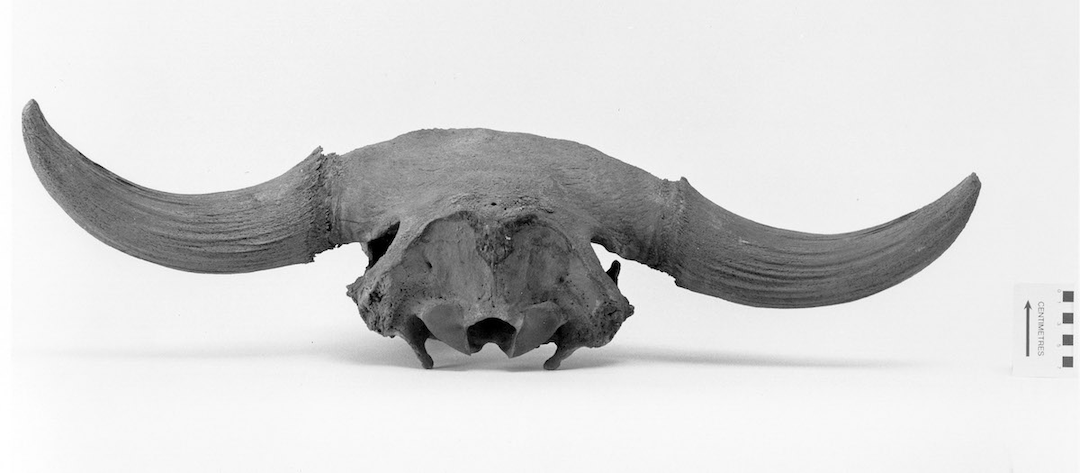Let Bisons be Bisons
The Muse Newsletter
Vol. 29 No. 4 – Fall 2019
by Morgan Saelens, Summer Student
On a cold winter day in 1979, an excavation crew began working on a project close to what is now the Kenora airport. Unbeknownst to them, they were about to unearth an archaeological discovery unlike anything this region had ever seen. When the shovel of the backhoe was raised from the bog, giant horns protruded from the waterlogged soil and the skull of a massive beast was brought to the surface for the first time since the Pleistocene epoch. Crew leader Nick Serduletz would later joke, “I told my friends I dug up the devil himself!”
It was apparent that this “devil” was some sort of bison but its presence this far northeast, in addition to its unusually massive size, sparked scientific intrigue both locally and internationally. Kenora residents and tourists alike in the 1980s took to the Kenora Shoppers Mall to see “The Kenora Super Bison” on display.

Through radiocarbon dating methods, archaeologists from the States and Canada discovered that this particular bison would have been alive 4,850 ± 60 years ago, making it undisputedly, the youngest example of a taxon of bison that has been extinct for thousands of years.
Bison antiquus occidentalis was far more massive than the bison of today with a body length up to 15 feet and horns measuring 3 feet from tip to tip. This male was far from his typical territory of open, grassy plains like those of our neighbouring province. So what was this fully grown, 3,000 pound bull doing wandering the wooded forests and muskegs of northern bush country all those years ago?
Further studies performed on the skull were able to assess that this male died under circumstances of exhaustion and nutritional stress or, in other words, he was tired, hungry and a long way from home. Such detailed clues about his life and death could be determined because of the high-quality of its preservation. The soil acidity, fungi and animal scavengers of this region typically degrade bone matter rather quickly, meaning that it would have been an anomaly for the skull to have remained intact for a decade, let alone thousands of years. However, the peat bog actually acted as the perfect time capsule. In other parts of the world, peat moss bogs are famous for their ability to preserve anything and everything from swords and objects to ancient bodies.
The bison’s presence in our region set a new and unprecedented boundary record, farther northeast than any of its kind. Some researchers have theorized that its presence could be consistent with glacial retreat estimations from tens of thousands of years prior, alluding to a more prairie-like ecosystem in the region than previously thought. Some wondered if perhaps the area had been a lot more like the open plains of Manitoba or Saskatchewan than we have been led to believe and perhaps bison could have existed here. These speculations ultimately were proven false using the dating methods on the skull. Its composition revealed that this bison would have been alive during a time when the Kenora area was an open, mixed woodland with environmental conditions the bison would have been ill-adapted for. This meant that he would have been passing through a wilderness not all that dissimilar from what we have now. While scientists and archaeologists have attempted to theorize what drove him to these parts, it is impossible to say. His presence shifted all preconceived estimations of the historical timeline for this species.
Unknowingly, Kenora had hosted a unique touchstone in time, somewhere near the midpoint of the species’ existence on this continent. Since its discovery the skull has changed hands a few times but now is part of the natural history collection of the Manitoba Museum in Winnipeg.
Did you know?
Group of Seven member, Frank Johnston, visited Kenora and painted “Serenity, Lake of the Woods” in 1922, a shoreline view of Kenora with it’s distinctive smoke stacks from the pulp and paper mills.
